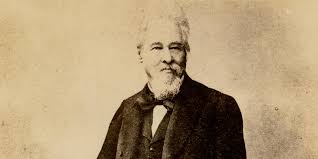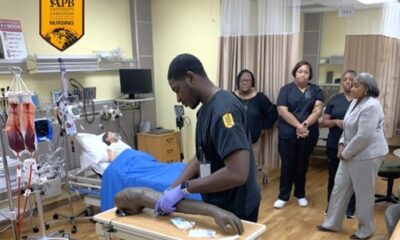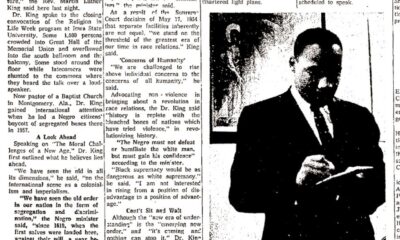Black History
Norbert Rillieux: The Man who Revolutionized the Sugar Industry Worldwide

February is Black History Month. And what better way to celebrate than to lift from obscurity African Americans who played crucial roles in this country’s scientific, cultural and industrial progress. Their achievements saved thousands of lives, made the lives of many Americans easier and in some instances changed the course of history. And yet, they are largely forgotten by the world they helped to change for the better. In this series, we will highlight some of these under-appreciated and forgotten men and women.
His was an invention that gained worldwide significance. He revolutionized the world’s sugar industry, and yet not many people know his name.
Norbert Rillieux, whose mother was a freed slave, was born March 17, 1806 on a New Orleans plantation. His father, the plantation’s owner, sent him to Paris, France for his education; perhaps because a proper education was unavailable in New Orleans for blacks, no matter their status.
“In Paris, Norbert turned out to be a brilliant student at L’Ecole Centrale,” according to Louis Haber, author of Black Pioneers of Science and Inventions. “He showed an extraordinary aptitude for engineering and at the age of twenty-four became an instructor of applied mechanics at L’ Ecole Centrale.”
He published many papers on steam engine and it was there that he developed the theory of multiple-effect evaporation that was to be the basis for his “precedent-shattering invention,” Haber wrote.
Rillieux learned that the boiling point of liquids is reduced as the pressure is reduced (like in a vacuum), according to Enchantedlearning.com. He applied this to the processing of sugar, heating the cane sugar in a vacuum, and re-using the steam in the processing procedure. This resulted in a highly efficient mechanical process that replaced the laborious, dangerous, and costly method of processing sugar by using a team of slaves called the “Jamaica train,” according to the online site.
Until 1846, the transformation of sugarcane juice into sugar was done by this primitive method. Some say that method may have left a mark on Rillieux.
“Perhaps Rillieux’s interest in the sugar refining process stemmed from his memory of seeing gangs of sweating slaves in New Orleans painfully pouring and ladling boiling sugarcane juice from one steaming, open kettle to another,” Haber wrote.
The resulting sugar tended to be of low quality since the heat in the kettles could not be regulated, and much sugar was lost in the process of transferring juice from kettle to kettle, according to a report by the American Chemical Society.
Rillieux wanted to find a way to refine and granulate sugar that produce the same sweetness but with less waste, without a team of slaves and without the crude effects.
Sugar is caramelized by high heat. With a vacuum the pressure is reduced during boiling. With a partial vacuum, the boiling temperature can be kept below the point at which caramelization takes place. Two scientists had developed vacuum pans with condensing coils that used heat in evaporating the liquid portion of the sugarcane juice. But their method was imperfect, Haber wrote.
Rillieux’s method enclosed the condensing coils in a vacuum chamber, allowing the vapor from the first condensing chamber to evaporate in a second chamber under a higher volume. The higher the vacuum, the lower the temperature needed to evaporate the liquid.
“The principles involved in this plan laid the foundation for all modern industrial evaporation,” Haber wrote.
Rillieux, who had returned to Louisiana, attempted to design an evaporator in 1834 and 1841, but they failed. In 1843, he was convinced to try again by a plantation owner and this time it was a success, producing sugar that was high in quality, Haber wrote.
The news spread. Rillieux had revolutionized the sugar industry by producing high-quality sugar at a cheaper price. Now only one person was needed to operate the machine through outside valves. The loss of sugar was also reduced while the quality had increased. Rillieux obtained patents for his inventions on Aug. 26, 1843 and Dec. 10, 1846.
Rillieux’s multi-effect vacuum evaporating chamber, a bulky locomotive-sized apparatus containing a network of condensing coils for evaporating the raw cane juice, grew in popularity.
“Soon factories all over Louisiana were installing the ‘Rillieux System,” Haber wrote. “Cuba and Mexico followed soon after.”
It was also used at thousands of other plantations throughout the southeastern United States and the Caribbean, according to Madehow.com.
“Eventually, refined sugar crystals, which were a specialty item, became an ordinary commodity for which refiners found increasing markets,” according to the online site.
Today the process of evaporation in multiple effects is also used in the manufacture of condensed milk, soap, gelatin, and glue, and in the recovery of waste liquors in distilleries and paper factories, Haber wrote.
But despite his success Rillieux, who would often speak out about injustice, was a social pariah. Though he was not a slave, he was still black and was not accepted at the home of whites/
The pending Civil War brought even more restrictions for Rillieux and his race. They could not venture down the streets of New Orleans without permission and failing to leave the city when ordered meant years of imprisonment and hard labor. Rillieux took exception to this and was ordered to carry a pass, Haber wrote. It was too much for Rillieux and in 1854, he left. But not before trying to save many of its citizens.
Yellow fever, which was being carried by certain type of mosquitoes that breed only in water, was killing many. Rillieux worked out an engineering plan that would drain the swamps and get rid of the mosquitoes breeding ground, Haber wrote. But the plan was turned down because it came from a black man, Haber said. Years later, the city was forced to install a similar plan, he said.
Rillieux was now living in Paris and when France was producing most of its sugar from sugar beets, he applied his evaporating-plan process and in 1881 patented a process of heating juices with vapors in multiple effect, which is still used in cane and beet sugar factories throughout the world, Haber wrote.
Despite the world-wide impact of his inventions, Rillieux is virtually unknown. His name does not appear in chemistry or physics textbooks or in technical journals, Haber wrote. Still, in his book, Technology of Sugar, published in London in 1903, J. G. McIntosh wrote on the development and advantages of Rillieux’s inventions.
“This is the system which constitutes the basis of all saving in fuel hitherto effected in sugar factories. Rillieux may therefore, with all justice, be regarded as one of the greatest benefactors of the sugar industry.”
Rillieux died in Paris, France on Oct. 8, 1894. More than 30 years later, a worldwide movement began to honor Rillieux. It began in Holland and grew to include organizations that represented every sugar-producing country in the world. A bronze plaque of Rillieux was designed in Amsterdam, Haber wrote. It’s now on display in the Louisiana State Museum in New Orleans, he said.
In 2002, the American Chemical Society designated the invention of the multiple-effect evaporator under vacuum a National Historic Chemical Landmark, according to invent.org.

-

 Black History5 months ago
Black History5 months agoThe untold story of a Black woman who founded an Alabama hospital during Jim Crow
-

 Featured9 months ago
Featured9 months ago‘No Closure’ In Town Where Five Black Residents Were Either Murdered, Died Suspiciously Or Are Missing
-

 Black History9 months ago
Black History9 months agoBlack History Lost and Found: New Research Pieces Together the Life of Prominent Texas Surgeon and Activist
-

 Featured9 months ago
Featured9 months agoFounder of “The Folding Chair” Podcast Calls Montgomery’s Brawl ‘Karma’
-

 Featured8 months ago
Featured8 months agoThousands ‘Live Their Dream’ During National Black Business Month
-

 Featured10 months ago
Featured10 months agoJuneteenth And ‘246 Years Of Free Labor’ Are Key To Conversations About Reparations









